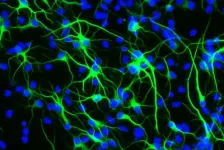Data show lower daily temperatures lead to higher transmission of COVID-19
Researchers analyzed daily low temperatures and infection rates in 50 Northern Hemisphere countries to quantify their effect on SARS-CoV-2 transmission
2021-02-19
(Press-News.org) LOUISVILLE, Ky. - The SARS-CoV-2 pandemic has caused tremendous upheaval, leading to more than 2.3 million deaths worldwide and 465,000 in the United States. Understanding the impact of seasonal temperature changes on transmission of the virus is an important factor in reducing the virus's spread in the years to come.
SARS-CoV-2 belongs to a large family of human coronaviruses, most of which are characterized by increased transmission in cooler, less humid months and decreased transmission in warmer, more humid months. With this understanding, researchers at the University of Louisville's Christina Lee Brown Envirome Institute, the Johns Hopkins University School of Medicine, the U.S. Department of Defense Joint Artificial Intelligence Center and others theorized that atmospheric temperature also would affect transmission of SARS-CoV-2.
The researchers compared daily low temperature data and logged cases of COVID-19 in 50 countries in the Northern Hemisphere between Jan. 22 and April 6, 2020. Their research, published this week in PLOS ONE, showed that as temperatures rose, the rate of new cases of COVID-19 decreased.
The data analysis showed that between 30 and 100 degrees Fahrenheit, a 1-degree Fahrenheit increase in daily low temperature was associated with a 1% decrease in the rate of increase in COVID-19 cases, and a 1-degree decrease in temperature was associated with an increase in that rate by 3.7%. By analyzing data from early in the pandemic, the results were obtained without significant influence by lockdowns, masking or other social efforts to contain the virus.
"Although COVID-19 is an infectious disease that will have non-temperature dependent transmission, our research indicates that it also may have a seasonal component," said Aruni Bhatnagar, Ph.D., co-author and director of the Brown Envirome Institute. "Of course, the effect of temperature on the rate of transmission is altered by social interventions like distancing, as well as time spent indoors and other factors. A combination of these factors ultimately determines the spread of COVID-19."
The researchers concluded that summer months are associated with slowed transmission of COVID-19, as in other seasonal respiratory viruses. This seasonal effect could be useful in local planning for social interventions and timing of resurgence of the virus.
In the United States, sharp spikes in COVID-19 were seen over the summer, but the researchers noted that based on the data they analyzed, cooler summer temperatures may have resulted in an even higher number of cases. The data also indicates that the correlation between temperature and transmission was much greater than the association between temperature and recovery or death from COVID-19.
"This understanding of of the SARS-CoV-2 temperature sensitivity has important implications for anticipating the course of the pandemic," said Adam Kaplin, M.D., Ph.D., of Johns Hopkins, first author of the study. "We do not know how long the currently available vaccines will sustain their benefits, nor what the risks are of new variants developing over time if the Northern and Southern Hemispheres continue to exchange COVID-19, back and forth across the equator, due to their opposing seasons. But it is reasonable to conclude that this research suggests that, like other seasonal viruses, SARS-CoV-2 could prove to be extremely difficult to contain over time unless there is a concerted and collaborative global effort to work to end this pandemic."
INFORMATION:
ELSE PRESS RELEASES FROM THIS DATE:
2021-02-19
HSE University researchers Yuri Markov and Natalia Tyurina discovered that when people visually estimate the size of objects, they are also able to consider their distance from the observer, even if there are many such objects. The observers rely not only on the objects' retinal representation, but also on the surrounding context. The paper was published in the journal Acta Psychologica.
Multiple studies in visual 'ensemble statistics' have proven that humans are able to visually estimate the statistical characteristics of multiple objects in a fast and rather ...
2021-02-19
ROCHESTER, Minn. ? Researchers at Mayo Clinic have combined results from a functional test measuring the effect of inherited variants in the BRCA2 breast and ovarian cancer gene with clinical information from women who received genetic testing to determine the clinical importance of many BRCA2 variants of uncertain significance (VUS). The findings were published today in a study in the American Journal of Human Genetics.
"There are 4,565 different VUS in the BRCA2 gene listed in the National Institutes for Health (NIH) Clinical Variant Database," says Fergus Couch, Ph.D., a breast cancer researcher at ...
2021-02-19
A gene linked to unusually long lifespans in humans protects brain stem cells from the harmful effects of stress, according to a new study by Weill Cornell Medicine investigators.
Studies of humans who live longer than 100 years have shown that many share an unusual version of a gene called Forkhead box protein O3 (FOXO3). That discovery led Dr. Jihye Paik, associate professor of pathology and laboratory medicine at Weill Cornell Medicine, and her colleagues to investigate how this gene contributes to brain health during aging.
In 2018, Dr. Paik and her team showed that mice who lack the FOXO3 gene ...
2021-02-19
How much personal information can our phone apps gather through location tracking? To answer this question, two researchers - Mirco Musolesi (University of Bologna, Italy) and Benjamin Baron (University College London, UK) - carried out a field study using an app specifically developed for this research. Through the app employed in the study - published in Proceedings of the ACM on Interactive, Mobile, Wearable and Ubiquitous Technologies - researchers were able to identify which kind of personal information the app extracted and its privacy sensitivity according to users.
"Users are largely unaware of the privacy implications ...
2021-02-19
The University of Leeds has coordinated a study with 170 experts from 35 countries, including E.T.S. Agronomic Engineering lecturer Luis Perez Urrestarazu. The study conclusions have just been published in the journal Nature Ecology & Evolution.
The researchers highlighted opportunities to improve the way green spaces are monitored and maintained and helping people to interact with and appreciate the natural world around them. Similarly, as autonomous vehicles become more widely used in cities, pollution and traffic congestion are set to fall.
But they also warn that advances in robotics and automation could be harmful to the environment. They may, for example generate new sources of waste and pollution, with potentially substantial negative implications for urban nature. Cities may ...
2021-02-19
Social identity is a factor linked to wellbeing and community participation. Various studies have demonstrated the link existing between ethnic identity and empowerment and that the interaction between both of them leads to a rise in the indices of wellbeing and community participation. However, the nature of these relationships may be determined by the fact that the individual perceives his or her own group as a minority one and/or one that is subject to discrimination. In fact, these relations emerge mostly in groups that find themselves in a minority situation and/or one of discrimination, but not in groups that are more hegemonic or in the majority.
To further ...
2021-02-19
Parent education programs and interventions that begin shortly after the birth of a child have shown to significantly impact parenting behaviors that support social and academic engagement for children growing up in poverty, according to a study led by pediatricians and psychologists across the country, including NYU Grossman School of Medicine, NYU Steinhardt, and the University of Pittsburgh.
The study, published today in the journal Pediatrics, examines the Smart Beginnings Project, a first-of-its-kind comprehensive approach to the promotion of school readiness in low-income families. This model addresses one of the most important causes of inequity - that many children from ...
2021-02-19
Researchers at the Institut de Neurociències of the Universitat Autònoma de Barcelona (INc-UAB) obtained a highly accurate recreation of human glioblastoma's features using a novel 3D microscopy analysis. The study, published in the journal Acta Neuropathologica Communications, provides new information to help with the diagnose, by finding therapeutical targets and designing immunotherapeutical strategies.
This new analysis of 3D images and quantitative data "will help to appreciate from within how the tumor is built in its full dimensionality, and to identify where different cell types are located", explains George Paul Cribaro, first author of the study. "It provides more complete information than the usual 2D analyses performed for ...
2021-02-19
Prion diseases are a group of rapidly progressive, fatal and infectious neurodegenerative disorders affecting both humans and animals: Bovine Spongiform Encephalopathy (BSE) or 'mad cow' disease is one of the most famous since in 1996 scientists found that the agent responsible for the disease in cows, is the same agent responsible for the so-called variant Creutzfeldt-Jakob Disease (vCJD), a disease affecting humans.
A new study carried out by SISSA - Scuola Internazionale Superiore di Studi Avanzati in collaboration with other institutions including Genos Glycoscience ...
2021-02-19
DURHAM, N.H.-- A new report from the University of New Hampshire's Crimes against Children Research Center (CCRC), using data collected by the U.S. Department of Health and Human Services, showed a marked increase in the share of child maltreatment cases resulting in fatalities as well as a decline in cases of physical abuse and neglect in 2019.
The report, which highlights 2019 statistics from the National Child Abuse and Neglect Data System (NCANDS), showed that fatalities rose 4%. The statistics gathered from child protection agencies in each state indicated that the uptick in child maltreatment fatalities was broadly distributed, with 25 states reporting an increase of 10% or more. This increase in fatalities continues an already upward trend ...
LAST 30 PRESS RELEASES:
[Press-News.org] Data show lower daily temperatures lead to higher transmission of COVID-19
Researchers analyzed daily low temperatures and infection rates in 50 Northern Hemisphere countries to quantify their effect on SARS-CoV-2 transmission



